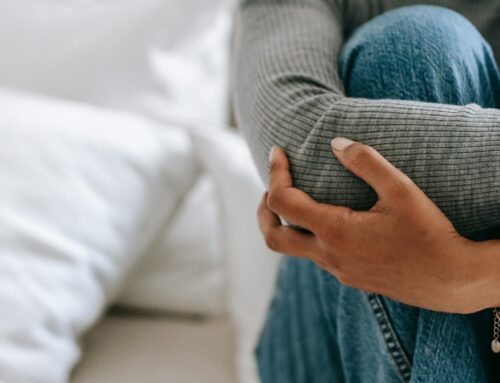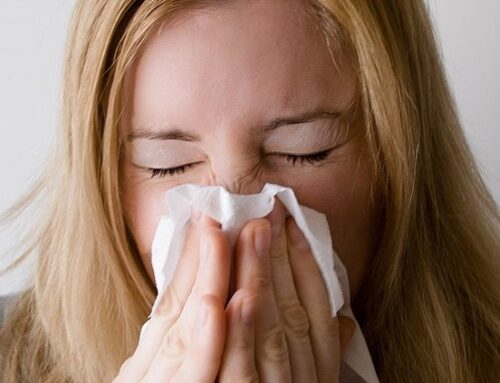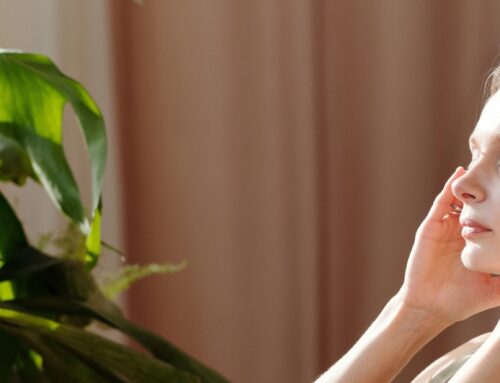with a focus on the perimenopause
Although I have focused on the menopausal time in this article, the suggestions for promoting breast health are relevant at all stages of a woman’s life, so regardless of your age, if you’re female, read on!
In this article I cover:
- Common benign breast problems
- The mind–body connection: the nurturing principle
- Improve circulation and detox:
- Go bra-less, or at least ditch the underwire!
- Body brushing and self-massage
- Castor oil pack
- Movement and relaxation
- Diet
- Homeopathy, tissue salts and essential oils
In our 40s and early to mid 50s, there can be increase in the tendency to breast lumps and other concerning signs or symptoms. By far the majority of these will be benign, but it is important to get any symptoms checked by your doctor, who is likely to refer you for imaging at a hospital breast unit.
Common benign breast problems
Cysts: Breast cysts are common in pre-menopausal women and are increasingly common as women approach menopause. They are formed when there is an accumulation of fluid one or more lobules (milk-producing glands). If they are large and causing discomfort they can be easily drained by the doctor with a needle.
Fibrocystic changes: This is a collective term for non-cancerous changes that can make the breasts feel lumpy, and sometimes swollen or sore, the degree to which can fluctuate over the monthly cycle. This term encompasses both cysts and a range of fibrotic tissue changes and are linked to monthly fluctuation in hormone levels. Over half of women will develop fibrocystic breast changes at some point.
Breast tenderness or pain: Many women suffer from breast pain or tenderness in the run up to their period each month as fluid accumulates under the influence of hormones. This can become more exaggerated approaching the menopause due to the more erratic changes in hormones and the oestrogen dominance that often occurs at this time.
There are other benign breast conditions – these are just some of the most common. Of course, the problem we most fear is breast cancer. It’s important to get checked by your doctor to exclude cancer if you have any of the following: a lump or thickening in the breast or underarm; a change in the size or shape of the breast; dimpling, puckering, redness, warmth or darkening of the skin on your breast; changes to the nipple or nipple discharge.
The mind–body connection: the nurturing principle
When I think about breast problems, I often see the connection with nurturing or the mothering principle. For many of us, the perimenopause is a time that brings these roles or mothering and being mothered into sharp focus.
For many women the approach of the menopause is a time when our day-to-day mothering role changes as offspring become more independent. If we haven’t had children or our size of our family is not as planned, our feelings around these issues are also something that we find ourselves facing as our fertility declines.
A major issue that comes up for women is the issue of being mothered or nurtured and learning the art of self-mothering. On the one side, issues with one’s own mother can arise at this time. The ‘other side of the coin’ is that as adults, we are ultimately called to truly look after ourselves, to mother ourselves, with deep compassion and love. This is difficult for many of us due to how we were parented and the patterns set up during our childhood. We all have those rejected parts of ourselves – those aspects of ourselves that feel most unforgivable, vulnerable, scared or shamed. We need to learn to nurture and soothe our ‘inner child’.
Dr Christiane Northrup agrees. ‘Breasts are a physical metaphor for giving and receiving’ she says in Women’s Bodies, Women’s Wisdom.(1) She calls them the ‘organs of nurturance’. She identifies breast problems with many women’s tendency to ‘overgive’ without allowing themselves to be on the receiving end of support and nurture, both from others and self.
She also relates breast problems to the heart chakra, and the issues of unexpressed or unresolved emotions such as grief, hurt, sorrow or regret. In this modern culture that rewards an outer show of coping and control, we can end up dismissing the healing value of allowing ourselves to fully express, process and then release our emotions.
- Do you overgive to those in your life?
- Do you allow yourself to receive the same sort of support you give to others?
- Are you able to comfort and soothe your wounded ‘inner child’?
- Are you processing your difficult emotions or stuffing them down?
Improve circulation and detox
Go bra-less, or at least ditch the underwire!
Ensuring good blood and lymph circulation to the breasts is important. If you wear an underwired or restrictive bra this may be impeding flow of these fluids and the drainage of toxins from the breast tissues. Consider changing to a non-underwired bra. There are so many new styles of bras and novel stretchy fabrics being used. What sort you choose will be dependent the size of your breasts, as well as the activity you’re wearing it for. If it feels comfortable, go bra-less sometimes, especially when pottering around at home. It can be quite liberating!
Body brushing and self-massage
Not only does massage and/or dry body brushing stimulate the blood and lymphatic circulation in the breast and underarm area it can also help you check in regularly with your breasts and get to familiar what normal feels like for you. Be gentle, as the tissues of the breast are delicate. Massage in a circular way around the nipple moving in an outwards direction. You can also use outward sweeps from the nipple radially and up towards the armpit, following the direction of lymphatic drainage. See links to articles and videos at the end of this article for ‘how-to’ details.(2–4) Please ensure that any possibility of malignancy has been excluded before using these techniques.
Castor oil pack
Castor oil penetrates deep into the tissues. The topical use of castor oil packs for drawing out impurities and reducing inflammation is long-established and can be used on many parts of the body – not least the breasts. This can be a very helpful thing to do to help tender, swollen or cystic breasts. Saturate a clean cloth in castor oil and place it on the breasts. Cover it with another clean, dry cloth and then place a warm (not hot) water bottle on top of that. Allow that to work for 30 minutes while you relax with a good book or your favourite comedy. Note that castor oil will stain, so be careful of your clothing. Repeat three times a week all the while your breasts are tender or symptomatic.
Movement and relaxation
Get moving to increase the movement of Qi around your breasts. In physiological terms, again we’re talking about optimising blood and lymph flow but also balancing the efficiency of metabolic and cellular processes. We can carry a surprising amount of tension in the muscles around the breasts; in addition, physical and psychological traumas, stress and poor posture can tighten the not only the muscles but the fascia around the chest (fascia is the continuous network of connective tissue surrounding all organs). Long, gentle yoga stretches opening up the chest can be of real benefit. Swimming or going for brisk walks are also good. Guided relaxations and visualisations can also be useful in relaxing this area, as can Epsom salts baths.
Diet
Many women find that the symptoms of fibrocystic breasts, especially breast tenderness is improved by limiting or excluding caffeine and alcohol.
There’s so much one could say about diet and long-term breast health, it’s worthy of an article in its own right. But I will just mention the essentials and a few easy dietary ‘wins’.
A good diet is the same whether it’s for breast health or any other aspect of health, and comprises a natural, wholefood diet that minimises processed food and contains plenty of fresh vegetables and fruit, as well as good sources of proteins and healthy fats. Fruit and vegetables are not only packed with antioxidants; they provide plenty of fibre which also has a protective effect on breast tissue by helping to breakdown and flush excess oestrogen and in this way has been found to reduce cancer risk.(5) Leafy greens are especially good. Also consider the following:
Reduce alcohol consumption: If you like your wine, and you only do one thing for the health of your boobs, this is a big one.
Lower your refined carbs: One of the biggest contributors to ill-health in the modern diet is the high level of refined carbohydrates. The effect of these foods in spiking insulin levels, producing excess oestrogen, and promoting cellular inflammation negatively impacts the hormone-sensitive breast tissue.
Add milled flaxseeds: These little seeds work on multiple levels when it comes to breast health. They provide plenty of fibre. They contain high levels of omega-3 fatty acids. They are also phytoestrogens and contain lignans, which have both anti-cancer and oestrogen-balancing effects.(6) Add them milled to yogurt, soups or other foods.
Add lacto-fermented foods or probiotics: I’m a big fan of fermented foods and probiotics and their role in health. You may be surprised to hear that the breast tissue has its very own microbiome,(7) and it has been found to differ between healthy and unhealthy breast tissue, especially when that unhealthy tissue is cancer. There is now interest in the use of probiotics in protection from breast cancer as well as helping to heal it. The helpful species of note here are Lactobacillus acidophilus and Lactobacillus plantarum,(8) which occur in naturally fermented foods such as yogurt, sauerkraut, kimchi and kefir. If you take a probiotic ensure one of these is in your supplement.
Vitamin supplements: There’s evidence to suggest that supplementing with vitamins B6 and E can be helpful for cyclical breast pain, although if you can get these from improving your diet, so much the better. For general breast health maintenance however, if you just add one vitamin supplement, make it vitamin D. Living at the northern latitudes as we do, most of us benefit from supplementing with this vitamin in the winter months, which not only has a protective effect from a range of cancers, it optimises our cardiovascular and immune health too.
Homeopathy, tissue salts and essential oils
Homeopathy
From a homeopathic point of view, many remedies can cover breast issues and the remedies that your homeopath will prescribe are based on your particular symptom picture and constitution. All homeopathic prescriptions are individualised and are aimed at treating the whole person. Some remedies cover cystic conditions better, while others are more likely to help with premenstrual discomfort, for example, but all will be prescribed on the wider picture as presented by each individual patient.
Phytolacca decandra (poke root): This powerful herb is used by herbalists and homeopaths alike and is considered a general organ support herb for breasts and a cleanser of the lymphatic system. When using it as an general breast remedy, homeopaths often prescribe it in a decimal (x) potency or sometimes in tincture. However, when it covers more specific symptoms it is given as a centesimal (c) potency. Because it’s a powerful herb with potentially toxic effects, I don’t recommend you self-prescribe, especially in herbal form.
Tissue salts
Some of the tissue salts that you might consider self-prescribing for low-level breast issues are:
Calc fluor: This is one of the main ones to think about for fibrous, lumpy breast tissue. This tissue salt is useful for helping to clear and support tissues that should be pliable and elastic but have become hard.
Silica: Silica also suggests itself for knotty and cystic breasts, as it is a known eliminator of toxins and has the ability to get rid of foreign substances. It has an affinity for glandular tissue, cystic processes and the lymphatics.
Essential oils
Some essential oils can be helpful to ease the discomfort of some of the benign breast issues listed above and you can add these to your massage oil:
Lavender: Known to be balancing to the female sex hormones as well as emotionally calming, this oil also has mild analgesic properties. This is one to consider for breast problems that come on in a cyclic manner before the period.
Frankincense: Frankincense oil is a good all-rounder for breast issues. It is anti-inflammatory, so can help with pain and swelling; is very calming and and a great stress-reliever. It may even have anti-tumour properties.
Geranium: Not only does this oils have a reputation to help support the hormonal cycle in women but it also helps improve the circulation, supporting lymphatic drainage and easing swellings. One to think about for swollen breasts before the period.
References
- Northrup C. Women’s Bodies, Women’s Wisdom: The Complete Guide to Women’s Health and Wellbeing. Rev Ed edition. London: Piatkus Books; 2009. 864 p.
- Healing Breast Massage [Internet]. The Women’s Wellness Collective. [cited 2021 Nov 22]. Available from: https://thewomenswellnesscollective.com/journal/2018/1/29/healing-breast-massage
- Cancer Rehab PT. Dry Brushing for Lymphatic Drainage – Shown the Best way by a Lymphedema Physical Therapist [Internet]. 2020 [cited 2021 Nov 22]. Available from: https://www.youtube.com/watch?v=1YnVb9Ie-r0
- Dana Waldie. Dry Body Brushing & Lymphatic Drainage PLUS Breast Health! [Internet]. 2020 [cited 2021 Nov 22]. Available from: https://www.youtube.com/watch?v=0eszso8FeVs
- Farvid MS, Spence ND, Holmes MD, Barnett JB. Fiber consumption and breast cancer incidence: A systematic review and meta-analysis of prospective studies. Cancer. 2020 Jul 1;126(13):3061–75.
- Calado A, Neves PM, Santos T, Ravasco P. The Effect of Flaxseed in Breast Cancer: A Literature Review. Front Nutr. 2018 Feb 7;5:4.
- The Breast Microbiome: A Role for Probiotics in Breast Cancer Prevention [Internet]. ASM.org. [cited 2021 Nov 22]. Available from: http://www.yourdomain.com/index.php/general-science-blog/item/6663-the-breast-microbiome-a-role-for-probiotics-in-breast-cancer-prevention
- Kassayová M, Bobrov N, Strojný L, Kisková T, Mikeš J, Demečková V, et al. Preventive effects of probiotic bacteria Lactobacillus plantarum and dietary fiber in chemically-induced mammary carcinogenesis. Anticancer Res. 2014 Sep;34(9):4969–75.











